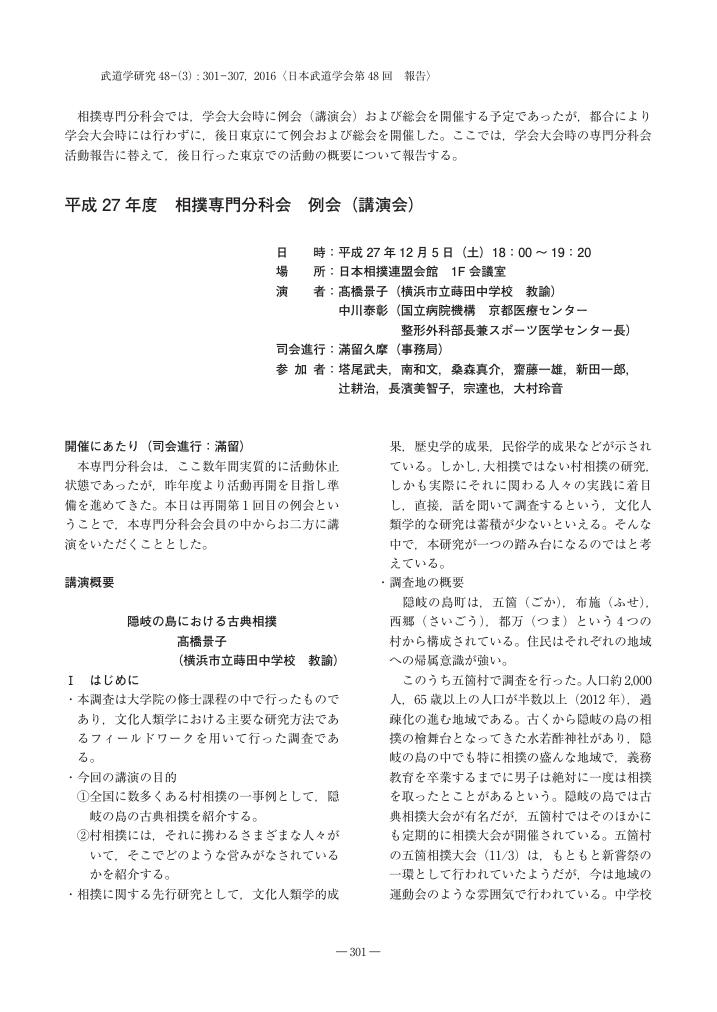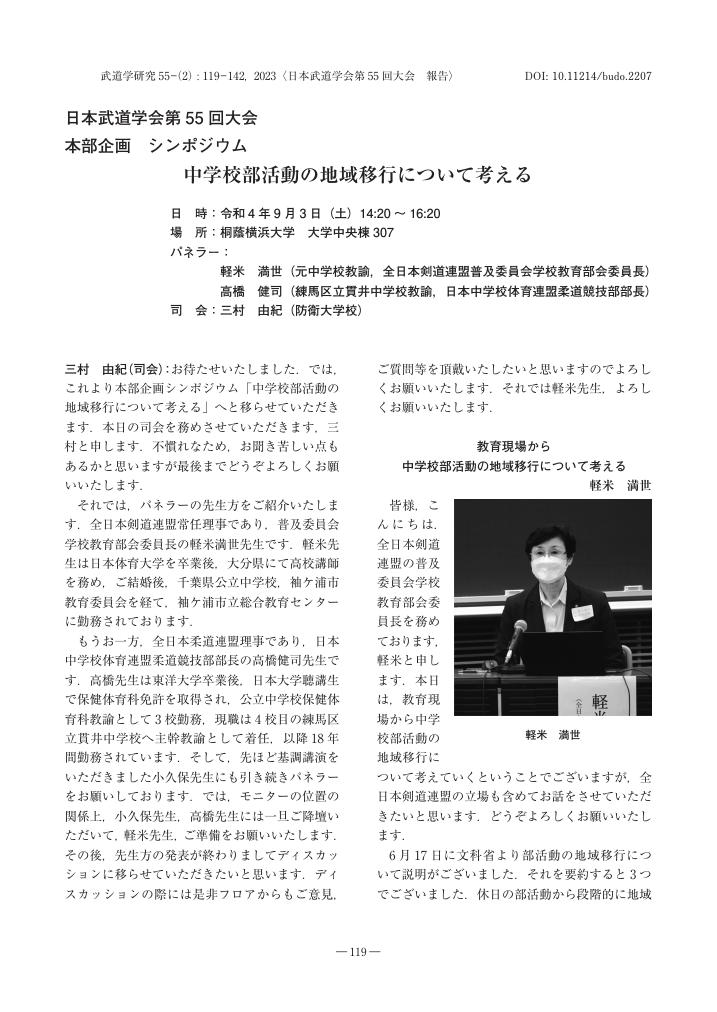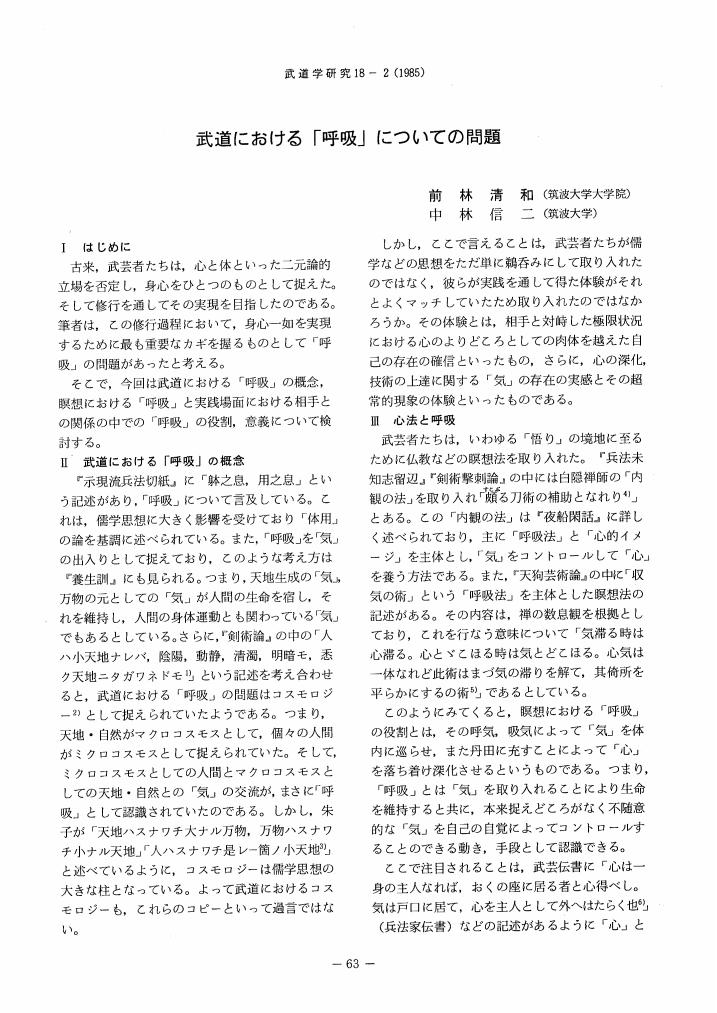1 0 0 0 OA 平成27年度 相撲専門分科会 例会(講演会)
1 0 0 0 OA 中学校部活動の地域移行について考える
1 0 0 0 OA 武道・スポーツの基礎となる棒の力学:特に慣性力の重要性
- 著者
- 坂井 伸之 牧 琢弥 竹田 隆一
- 出版者
- 日本武道学会
- 雑誌
- 武道学研究 (ISSN:02879700)
- 巻号頁・発行日
- vol.49, no.1, pp.15-27, 2016-08-18 (Released:2018-03-12)
- 参考文献数
- 5
- 被引用文献数
- 1
In budo and sports, most coaching words are abstract and intuitive, and their true meanings and scientific foundations are ambiguous. To understand complex movements scientifically, it is important to reduce them into simple models and to analyze them on the basis of mechanical laws. In this paper, as the first step in the theoretical study of movements, we consider the mechanics of bar models, which are applicable to various movements in budo and sports. In particular, we focus on the effects of inertial force on human movements, which have so far been overlooked. We also discuss the restorative force of muscles and gravity, which act in cooperation with inertial force. As a result, we found the mechanisms of some typical movements. For example, we interpret “kinetic link” as the combination of inertial force acting on a rigid body and restoring the force of muscles, and clarify the scientific meaning of “weight shift” in terms of the equivalence of gravity and inertial force.
1 0 0 0 OA 大学男女剣道選手の骨密度特性
- 著者
- 山神 眞一 石川 雄一 境 英俊 藤原 章司 阿部 純也 宮本 賢作 長野 智香
- 出版者
- 日本武道学会
- 雑誌
- 武道学研究 (ISSN:02879700)
- 巻号頁・発行日
- vol.37, no.3, pp.13-23, 2005-03-31 (Released:2012-11-27)
- 参考文献数
- 30
A study was conducted to investigate the influence of kendo exercise on the bone mineral density in male and female university kendo athletes. The subjects were 45 male university kendo athletes and 23 female university kendo athletes. They had an average kendo experience of 13.2 years and 10.0 years. Measurements were performed using an AOS100 (ALOKA Corp.). We measured the speed of sound (SOS), transmission index (TI), and osteo sonoassessment index (OSI). The mean values of SOS, TI, and OSI in male and female university kendo athletes were higher than in the same aged control group and the peak bone mass aged control group.The values of the left heel were significantly higher than that of the right heel in bone mineral density. Body weight was significantly related to bone mineral density in male and female university kendo athletes. These results suggest that regular kendo exercise during youth is effective for the increase in bone mineral density.
1 0 0 0 OA 武芸伝書にみられる事理について(その2)
- 著者
- 湯浅 晃
- 出版者
- 日本武道学会
- 雑誌
- 武道学研究 (ISSN:02879700)
- 巻号頁・発行日
- vol.18, no.2, pp.53-54, 1985-11-30 (Released:2012-11-27)
1 0 0 0 OA 正坐と結跏趺における丹田と重心の位置について
- 著者
- 浅見 高明 平井 仁
- 出版者
- 日本武道学会
- 雑誌
- 武道学研究 (ISSN:02879700)
- 巻号頁・発行日
- vol.27, no.1, pp.1-11, 1994-08-31 (Released:2012-11-27)
- 参考文献数
- 23
- 被引用文献数
- 1
The purposes of this study were firstly to observe relationship between positions of lower abdominal region (called “Seika-Tanden” in Japanese) and whole-body centers of gravity (CGs) in four types of the correct sitting posture (called “Seiza” in Japanese) and the sitting postures crossing legs on four conditions (called “Kekkahuza” in Japanese), and secondly to compare these postures by degree of spinal curvature which had measured with a conformateur. Four types of “Seiza” was prescribed as follows: (1) Tanza: incorrected “Seiza” , (2) Sokushinza: “Seiza” corrected with piling a top side in one foot on an arch of another foot, (3) Koushiza: “Seiza” corrected with crossing hallux, (4) Heishiza: “Seiza” corrected with placing toes side by side. Four conditions on “Kekkahuza” were (1) non-cushion, (2) one cushion, (3)add one more cushion, (4) add two more cushions. Estimation of CGs was based on H. Matsui's body segment parameters by means of pictures in profile. Positions of “Tanden” were obtained by T. Sato's drawing figure method. The subjects were eleven Judoist (on “Tanza” , “Sokushinza”,“Koushiza” and “Heishiza”) and a practician of “Zazen” (on “Kekkahuza”). The results were as follows:1) As to characteristics in each posture estimated by degree of spinal curvature,“Tanza” characterized by a shape of that like an alphabet C, and the lumbar curvature was not found. On the other hand, the corrected “Seiza” (“Sokushinza”,“Koushiza” and “Heishiza”) and “Kekkahuza” expressed curvatures like an alphabet S that showed the same characeristics as a standing posture.2) In both “Seiza” and “Kekkahuza”, the positions of CGs located above the navels, and the heights of CGs were higher than those of “Tanden”.3) In“Seiza”, the antero-posterior positions of CGs were more behind than those of “Tanden”(50%).4) About “Kekkahuza”, the antero-posterior positions of the CGs were in the rear of those of “Tanden” on all conditions (39.5-42.2%).
1 0 0 0 OA パラアーチェリーに学ぶ弓道の新たな可能性を探る
1 0 0 0 OA 大学生柔道選手におけるライフスキル獲得が競技成績に及ぼす影響
- 著者
- 山本 浩二 垣田 恵佑 島本 好平 永木 耕介
- 出版者
- 日本武道学会
- 雑誌
- 武道学研究 (ISSN:02879700)
- 巻号頁・発行日
- vol.51, no.2, pp.75-87, 2018-12-28 (Released:2019-12-28)
- 参考文献数
- 31
- 被引用文献数
- 5
The purpose of this research was to examine the effect of the acquisition of life skills on competitive results in Japanese university judo players considering the temporal delay between the two variables. 517 judo players who belong to private universities (12 universities in total) participated in this research. For the life skills survey, which was conducted between early-May and late-June 2014, the participants were asked to complete a questionnaire—the Appraisal Scale of Required Life Skills for College Student Athletes (Shimamoto et al., 2013)—before the competition. The competitive results of the participants were obtained from the All-Japan Student Judo Championship Competition (AJSCC) for university students held in Tokyo during late-September. First, participants were categorized into 2 groups: a “High Competitive Level Group (n=103)”, who participated in the above mentioned AJSCC, and a “Low Competitive Level Group (n=400)”, who did not participate in the AJSCC. The results of the t-test revealed that the life skill levels of the former group were significantly higher than the latter group regarding thinking carefully, communication, setting goals, always making one’s best effort, and taking responsibility for one’s own behavior. Secondly, the participants of the former group were classified into 3 groups based on the results of the AJSCC: a “High Competitive Result Group (HCRG, n=38)”, a “Middle Competitive Result Group (MCRG, n=28)”, and a “Low Competitive Result Group (LCRG, n=37)”. The results of the analysis of variance using the life skills data obtained before the AJSCC showed that: (1) on the level of being humble, HCRG is significantly higher than MCRG; (2) on the level of taking responsibility for one’s own behavior, HCRG is significantly higher compared to LCRG; (3) on the level of maintaining physical health and well-being, HCRG is significantly higher than the other 2 groups. It was suggested that the results of this study could lead to a coaching style to achieve high competitive results without violent behavior from coaches.
1 0 0 0 OA 史料から読み解く“薙刀”の特性
1 0 0 0 OA 「伊達世臣家譜」にみられる仙台藩の射手
- 著者
- 黒須 憲 入江 康平
- 出版者
- 日本武道学会
- 雑誌
- 武道学研究 (ISSN:02879700)
- 巻号頁・発行日
- vol.28, no.Supplement, pp.64, 1995 (Released:2012-11-27)
- 著者
- 増地 克之 町田 正直 松井 崇 薬師寺 巨久 金野 潤 小山 勝弘 岡田 弘隆 金丸 雄介 小俣 幸嗣 武政 徹
- 出版者
- 日本武道学会
- 雑誌
- 武道学研究 (ISSN:02879700)
- 巻号頁・発行日
- vol.42, no.2, pp.2_1-2_9, 2009-11-30 (Released:2012-08-28)
- 参考文献数
- 14
The purpose of this study is to evaluate “Speed Uchikomi” as a form of strength training. We measured the following variables to evaluate the efficiency of this training, the heart rate according to the different pace of uchikomi, and the percentage of maximal oxygen consumption calculated from the heart rate and RPE. Endocrinological data, such as plasma lactic acid, ACTH and GH levels were also measured. The results were as follows: 1) We inferred from the cardiorespiratory response that “Speed Uchikomi” exceeds 70% maximal oxygen consumption when the frequency is more than once every 1.5 seconds. Therefore, when we use uchikomi as strength training, it should be done at a frequency of more than once every 1.5 seconds. 2) A gradual increase in the plasma lactic acid level, depending on the uchikomi frequency, was observed. “Speed Uchikomi” with a rate of more than once every 1.5 seconds gives a higher value than that of the lactate threshold or onset of blood lactate accumulation. From its energy metabolism, “Speed Uchikomi” is effective as endurance training. 3) “Speed Uchikomi” with a frequency of once every second increased the plasma ACTH level compared with the resting level. In other words, it is suggested that uchikomi which is a basic judo practice, has a significant influence on the endocrine system. 4) After performing “Speed Uchikomi” at the rate of once every second, the plasma GH level increased higher than the resting level, which means it has an anabolic effect. 5) The training rate of once every second is very exhausting and is expected to be more efficient than training at a rate of once every 1.5 seconds, but training like this without planning also carries a risk of overworking.
- 著者
- 大矢 稔
- 出版者
- 日本武道学会
- 雑誌
- 武道学研究 (ISSN:02879700)
- 巻号頁・発行日
- vol.37, no.2, pp.1-14, 2004-11-30 (Released:2012-11-27)
- 参考文献数
- 71
- 被引用文献数
- 1
A portion of the supplementary description of “Fourth Kata for Tachi” leading up to the AI-CHUDAN form (both protagonists with swords raised to middle level posture) of Kendo Kata, Japan found in “Kendo Training Course Documents” has been deleted. The phrase “move forward in three relatively small steps” affects the subsequent content of the Kata in terms of rationale relating to distance maintained between protagonists. In other words, the deletion presents not only a problem relating to overall textual expression, but a far greater problem relating to the resulting omission of an essential element of the Fourth Kata.In this regard, using as many instructional texts relating to Japanese Kendo Kata as possible as reference material, I present below an evaluation of the deleted segment, insofar as it influences the Fourth Kata.The concept of sword-to-sword contact (KIRI-MUSUBI) in the form of a simultaneous attack by both protagonists (AI-UCHI) is the result of “the concept, promulgated in traditional sword techniques, of a frontal, vertical cut executed simultaneously by both protagonists derived from recombination of sword-to-sword contact techniques arising from either a descending, diagonal cut executed from the HASSO posture (with the sword held at the side of the head) or an upward diagonal cut from the WAKI-GAMAE (with the sword held low to the side) to produce sword-to-sword contact (KIRI-MUSUBI) in the form of a simultaneous, direct, vertical, frontal attack made by employing a large, expansive cutting motion with both protagonists engaging in fierce combat with an equal degree of confidence.”Considering the characteristics of posture together with footwork, the three steps forward must inevitably be relatively small to produce a wide gap between the protagonists. In addition to this, taking into overall consideration the fact that the technique employs a large, expansive cutting motion, the original form of sword-to-sword contact and vertical frontal cut, the footwork and distance traversed in a simultaneous attack by both protagonists (AI-UCHI), the retreating steps of the attacker (UCHIDACHI) in a situation with both protagonists in the AI-CHUDAN posture (both protagonists with swords raised to middle level posture) and safety considerations, it is clear that, since great care must be taken in establishing on appropriate distance between the protagonists, the three advancing steps must be relatively small to ensure a wide intervening gap.The deletion from the supplementary description in “Kendo Training Course Documents” is not merely a textual style related revision. That is to say, deletion of the elements “advancing in three small steps,” “making a frontal, vertical attack from a distance employing a large, expansive technique, ” and “using sword-to-sword contact (KIRI-MUSUBI) in the form of cuts executed by both protagonists simultaneously” not only clouds the rationale relating to distance maintained between protagonists but also in effect impedes transmission of Nippon Kendo Kata in correct form. The above illustrates that supplementary descriptions should be “advance in three relatively small steps, step in on the right foot and make a direct, frontal attack using a large, expansive cutting movement thereby producing simultaneous sword-to-sword contact.”
1 0 0 0 OA 平成16年度 日本武道学会剣道専門分科会 第一回指導法研究会報告書
- 出版者
- 日本武道学会
- 雑誌
- 武道学研究 (ISSN:02879700)
- 巻号頁・発行日
- vol.37, no.3, pp.43-53, 2005-03-31 (Released:2012-11-27)
1 0 0 0 OA 柔道専門分科会
1 0 0 0 OA 柔道競技におけるスコア獲得に有効な投技の戦術行動
- 著者
- 三宅 恵介 竹澤 稔裕 伊藤 潔 佐藤 伸一郎 廣瀬 伸良
- 出版者
- 日本武道学会
- 雑誌
- 武道学研究 (ISSN:02879700)
- 巻号頁・発行日
- vol.54, no.2, pp.103-113, 2022-03-31 (Released:2022-04-07)
- 参考文献数
- 36
The purpose of this study was to clarify the tactical actions of nage-waza that are effective in scoring in judo by using a notational match performance analysis, and to provide useful knowledge in the practical field of coaching. For this purpose, we examined the relationship between (1) the type of nage-waza, (2) whether there was a renraku-henka in the nage-waza, and (3) the combination of the tori and the uke’s kumite and whether an athlete scored any points. Data from a total of 441 matches in the −60kg, −81kg, and +100kg weight classes in international competitions held in 2020 were used.The tactical actions associated with whether points were scored or not were the type of nage-waza and whether they included a renraku-henka. The combination of tactical actions that influenced the points scored was a combination of henka-waza and te-waza, and in some weight classes, combinations of henka-waza and other techniques were also effective. The combination of henka-waza and sumi-otoshi, which is classified as a te-waza, showed the highest scoring ratio in all weight classes.This study suggests for the first time that henka-waza, especially sumi-otoshi, applied during or after the opponent’s attack, is an effective tactical action for scoring regardless of weight class. These new findings indicate that in current judo competitions it is important to not only pursue single techniques but to construct tactical actions relative to the opponent. They are also expected to be useful for specific guidance in coaching.
1 0 0 0 OA 武道における「呼吸」についての問題
1 0 0 0 OA 西洋剣技の武術からスポーツへの変遷過程に関する一考察
- 著者
- 柴田 将男
- 出版者
- 日本武道学会
- 雑誌
- 武道学研究 (ISSN:02879700)
- 巻号頁・発行日
- vol.14, no.2, pp.1-2, 1982-01-31 (Released:2012-11-27)
- 参考文献数
- 9
1 0 0 0 OA わが国における「霊剣」思想の源流について
- 著者
- 酒井 利信
- 出版者
- 日本武道学会
- 雑誌
- 武道学研究 (ISSN:02879700)
- 巻号頁・発行日
- vol.21, no.2, pp.17-18, 1988-11-30 (Released:2012-11-27)
- 参考文献数
- 3
- 著者
- 松井 紳一郎 青木 豊次 高田 十志和
- 出版者
- 日本武道学会
- 雑誌
- 武道学研究 (ISSN:02879700)
- 巻号頁・発行日
- vol.23, no.3, pp.55-62, 1991-03-30 (Released:2012-11-27)
- 参考文献数
- 8
- 被引用文献数
- 2
Differences of physical construction between fighting Judo players often exert serious effects on the result of the match. However, some competitions in Japan are carried out regardless of considerating the constitutional differences, especially weight difference. It is important to examine the effects of constitutional differences on the match, since need of the open-weight class is discussed in the international Judo competitions.In this study, the effects of the constitutional differences (height and weight) on the Judo matches were investigated by analysing the success of the all Japan Judo championship competitions from Showa 55th (1980) to Heisei 1st (1989)The maior findings obtained were as follows:1. There was no significant difference in the number of victories between taller and shorter players in.32,2, matches in which difference of height was appreciated. Slight advantage was found in taller players, when the difference of body height was 6 cm or greater.2. When the difference of body weight was less than 20kg, there wes no effect on the success of the matches. In the matches with weight difference of 20-40kg, heavier players tended to be superior to lighter players, but the ratio of the success of match was 153: 128, indicating no significant difference. It is clear that when the weight difference was more than 40kg, heavier players was advantageous.3. Both the weight and the height differences show no effect on the success of the matches at the first half of the tournament (the 1st and 2nd tournaments), but at the second half of the tournament (from 3rd tournament to the final) heavior players were easier to win than lighter players.4. The main difference was observed in the number of “Ippon”, in the win of the matches between players with superior and inferior constitutions.In summary, it is suggested that most of participants (ca.74% of all) can have an equal opportunity of success in the all Japan championship competition. This may justify the existence of the Judo competition without distinction of weight.










